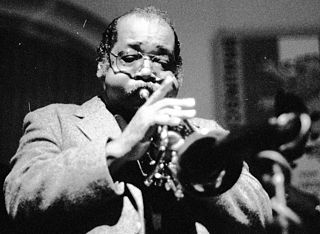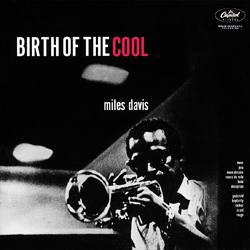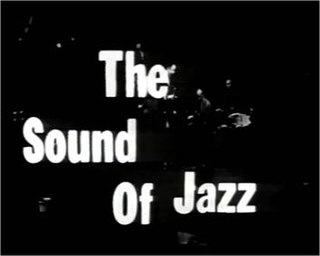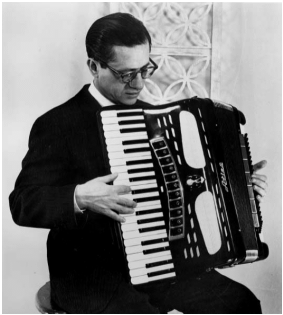Robert Herridge | |
|---|---|
| Born | Robert Herridge January 12, 1914 New Jersey, U.S. |
| Died | August 14, 1981 (aged 67) Woodstock, New York, U.S. |
| Occupation | Poet, short story writer, television writer and producer |
| Years active | 1939–1981 |
Robert Herridge (January 12, 1914 - August 14, 1981), [1] was a television producer and writer who created the CBS television program Camera Three , among more than 1,700 hours of TV programming, beginning in 1950. [1]
Herridge also served as a writer for the Studio One television series in 1948.[ citation needed ]
He produced one of the first American network television shows specifically about jazz, the one-hour "The Sound of Jazz", a December 8, 1957 edition of the CBS television series The Seven Lively Arts . [2] "The Sound of Jazz" was essentially a broadcast jam session including many luminaries of jazz, such as Miles Davis, Roy Eldridge, Coleman Hawkins, Ben Webster, Lester Young, Thelonious Monk, Milt Hinton, and Billie Holiday.
Herridge produced and hosted The Robert Herridge Theater, a half-hour dramatic anthology that ran in syndication circa 1959-1960 [3] or in 1961 [4] (sources vary), primarily on educational television stations. [4] One edition, "The Sound of Miles Davis", which Herridge referred to onscreen as "a story told in the language of music", consisted of an April 2, 1959, jazz concert by Davis, John Coltrane, Wynton Kelly, Paul Chambers, Jimmy Cobb, and the Gil Evans Orchestra at CBS TV's Studio 61. It aired July 21, 1960. [5] [6]
Herridge's professional interests extended beyond the world of Jazz as well. In the realm of classical music, he also produced the prime-time special Spring Festival of Music for CBS Television in 1960. The program was created at CBS in collaboration with the director Roger Englander. It showcased performances by several leading American musicians and orchestral ensembles including: Alfredo Antonini, John Browning, the Philadelphia Orchestra and the Symphony of the Air. [7]
During the course of his career, Robert Herridge was the recipient of several professional awards including the George Foster Peabody Award and three Emmy Awards. [1]
Herridge died of a heart attack at his home in Woodstock, New York. [1]
Nathan Irving Hentoff was an American historian, novelist, jazz and country music critic, and syndicated columnist for United Media. Hentoff was a columnist for The Village Voice from 1958 to 2009. Following his departure from The Village Voice, Hentoff became a senior fellow at the Cato Institute and continued writing his music column for The Wall Street Journal, which published his works until his death. He often wrote on First Amendment issues, vigorously defending the freedom of the press.

Nathaniel Carlyle Adderley was an American jazz trumpeter. He was the younger brother of saxophonist Julian "Cannonball" Adderley, whom he supported and played with for many years.
The following is the 1959–60 network television schedule for the three major English language commercial broadcast networks in the United States. The schedule covers primetime hours from September 1959 through March 1960. The schedule is followed by a list per network of returning series, new series, and series cancelled after the 1958–59 season.

Giant Steps is the fifth studio album by jazz musician John Coltrane as leader. It was released in February 1960 on Atlantic Records. This was his first album as leader for Atlantic Records, with which he had signed a new contract the previous year. The record is regarded as one of the most influential jazz albums of all time. Many of its tracks have become practice templates for jazz saxophonists. In 2004, it was one of fifty recordings chosen that year by the Library of Congress to be added to the National Recording Registry. It attained gold record status in 2018, having sold 500,000 copies.

Father Knows Best is an American sitcom starring Robert Young, Jane Wyatt, Elinor Donahue, Billy Gray and Lauren Chapin. The series, which began on radio in 1949, aired as a television show for six seasons and 203 episodes. Created by Ed James, Father Knows Best follows the lives of the Andersons, a middle-class family living in the Midwestern town of Springfield. The state in which Springfield is located is never specified, but it is generally accepted to be located in the Midwestern United States.

Birth of the Cool is a compilation album by American jazz musician Miles Davis, released in February or March 1957 on Capitol Records. It compiles eleven tracks recorded by Davis's nonet for the label over the course of three sessions during 1949 and 1950.

"The Sound of Jazz" is a 1957 edition of the CBS television series The Seven Lively Arts and was one of the first major programs featuring jazz to air on American network television.

The Seven Lively Arts is an American anthology series that aired on Sunday afternoons in 1957 on CBS television. The series was executive produced by John Houseman, and hosted by New York Herald Tribune critic John Crosby. Alfredo Antonini served as the musical director for several episodes. The title was taken from the influential book of the same name written by the cultural critic Gilbert Seldes, in which he argued that the low arts deserved as much critical attention as the high arts. The eleven programs produced were—not in order:

The United States Steel Hour is an anthology series which brought hour long dramas to television from 1953 to 1963. The television series and the radio program that preceded it were both sponsored by the United States Steel Corporation.

Miles Smiles is an album by jazz musician Miles Davis, released in January 1967 on Columbia Records. It was recorded by Davis and his second quintet at Columbia 30th Street Studio in New York City on October 24 and October 25, 1966. It is the second of six albums recorded by Davis's second great quintet, which featured saxophonist Wayne Shorter, pianist Herbie Hancock, bassist Ron Carter, and drummer Tony Williams.

Porgy and Bess is a studio album by jazz musician Miles Davis, released in March 1959 on Columbia Records. The album features arrangements by Davis and collaborator Gil Evans from George Gershwin's 1935 opera of the same name. The album was recorded in four sessions on July 22, July 29, August 4, and August 18, 1958, at Columbia's 30th Street Studio in New York City. It is the second collaboration between Davis and Evans and has garnered much critical acclaim since its release, being acknowledged by some music critics as the best of their collaborations. Jazz critics have regarded the album as historically important.

John Serry Sr. was an American concert accordionist, arranger, composer, organist, and educator. He performed on the CBS Radio and Television networks and contributed to Voice of America's cultural diplomacy initiatives during the Golden Age of Radio. He also concertized on the accordion as a member of several orchestras and jazz ensembles for nearly forty years between the 1930s and 1960s.

James Mundell Lowe was an American jazz guitarist who worked often in radio, television, and film, and as a session musician.

John Browning was an American pianist known for his reserved, elegant style and sophisticated interpretations of Bach and Scarlatti and for his collaboration with the American composer Samuel Barber.
Alfredo Antonini was a leading Italian-American symphony conductor and composer who was active on the international concert stage as well as on the CBS radio and television networks from the 1930s through the early 1970s. In 1972 he received an Emmy Award for Outstanding Achievement in Religious Programming on television for his conducting of the premiere of Ezra Laderman's opera And David Wept for CBS television during 1971. In addition, he was awarded the Order of Merit of the Italian Republic in 1980
"How Deep Is the Ocean?" is a popular song written by Irving Berlin in 1932. The song was developed from an earlier Berlin song "To My Mammy" which was sung by Al Jolson in his film Mammy (1930). In the earlier song, the lyrics include the questions "How deep is the ocean? / How high is the sky?" and this was the genesis of "How Deep Is the Ocean?".
Frank Rehak was an American jazz trombonist. He began on piano and cello before switching to trombone. He worked with Gil Evans and Miles Davis. He also appeared with Davis on the broadcast "The Sounds of Miles Davis."
Air Power is a historical educational television series broadcast in the 1950s over the CBS television network dealing with the rise of aviation as a military weapon. It was produced in cooperation with the U.S. Air Force. The series also featured a musical score composed by Norman Dello Joio and conducted by Alfredo Antonini.
The Robert Herridge Theater is a 30-minute American television anthology series of dramas by noted authors like John Steinbeck and Edgar Allan Poe. It was produced and hosted by Robert Herridge for CBS Films, Inc.. A total of 26 episodes were broadcast on CBS television from 1959–60. Among its guest stars were Robert Duvall, Maureen Stapleton, William Shatner, Sydney Pollack, Miles Davis and Eli Wallach.
CBS Workshop, aka CBS Repertoire Workshop is an hour-long dramatic television anthology series that was produced by and aired on CBS mid-day on Sundays in 1960. There were a total of twenty-five episodes with guest stars that included Maureen Stapleton, Raul Davila, Ossie Davis, Larry Hagman, Fritz Weaver, and Andrew Prine. Collaborators from the realm of opera included the conductor Alfredo Antonini and the soprano Martina Arroyo Contributors from the world of modern American dance included Alwin Nikolais, Murray Louis and Ruth Page